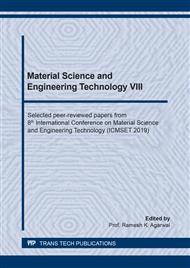p.21
p.30
p.36
p.42
p.48
p.55
p.61
p.71
p.78
Influence of Ni Content on Erosive Wear and Destabilization Heat Treatment Conditions Behavior of Multi Component White Cast Iron
Abstract:
This study investigated the influence of nickel (Ni) addition on erosive wear property of multi-component white cast iron with good erosive wear resistance. Multi-component white cast irons (MWCIs) with 2 mass % of carbon (C), 5 mass % of chromium (Cr), molybdenum (Mo), tungsten (W), niobium (Nb) and 0, 3, 5 mass % of Ni were prepared as experimental materials. The heat treatment condition was quenching by forced air cooling after keeping the specimens at 1123K for 3.6ks. Specimens with size of 50mm×50mm×10mm were tested using a suction-type blasting machine. The test was conducted with impact angle of 30, 60 and 90 deg. at room temperature. Collision particles were irregular steel grids with average particle diameter of 770μm and hardness of 810HV1. The speed of air flow was about 100m/s while the speed of impact particles was around 20.0g/s and the total time of each experiment was 3600 sec.. According to the result, erosion rate was decreased with the increase of Ni content in all of the impact angles. Especially, MWCIs which contain 5 mass % Ni showed the most excellent erosive wear resistance. As reasons, it can be considered that with Ni addition, the volume fraction of eutectic carbides and secondary carbides was increased which enhanced the matrix structure and suppressed the surface deformation of the experimental surface. Therefore, the increasing of eutectic carbides and secondary carbides can be considered as the reason of erosive wear resistance increased.
Info:
Periodical:
Pages:
48-54
Citation:
Online since:
June 2020
Authors:
Price:
Сopyright:
© 2020 Trans Tech Publications Ltd. All Rights Reserved
Share:
Citation:


